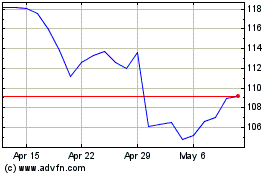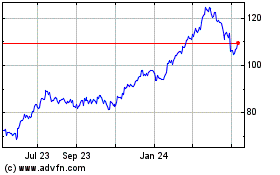UPS Is Adding 730 Alternative-Fuel Trucks to Its Fleet
June 19 2018 - 3:05PM
Dow Jones News
By Jennifer Smith
United Parcel Service Inc. is growing its fleet of
alternative-fuel trucks as the delivery giant pushes to reduce fuel
costs and vehicle emissions.
The parcel carrier is spending $130 million to buy 730
compressed natural-gas vehicles, boosting its current CNG fleet by
about 19%, and to add five CNG fueling stations to its existing
network of more than 50 stations, UPS announced Tuesday. The new
equipment includes 400 Freightliner and Kenworth big rigs from
Daimler Trucks North America and Paccar Inc., respectively, and 330
terminal trucks, which move trailers around UPS facilities, from
TICO Manufacturing and Power Solutions International, Inc.
The UPS investment is part of a broader effort to trim the
company's greenhouse-gas emissions from its ground operations by
12% by 2025. It comes as the company is investing $20 billion to
automate its facilities and upgrade technology as it adjusts to
swelling volumes of e-commerce packages bound for consumers'
doorsteps. Such deliveries tend to be less profitable than
drop-offs at businesses.
Fuel is historically the biggest expense for transportation
companies. While diesel prices dipped in 2015 and 2016, the cost
has been climbing again. Over the past four weeks, the average
on-highway price hovered between $3.239 to $3.288 a gallon,
according to the U.S. Energy Information Administration. Last year,
UPS's fuel expenses jumped 27% on higher prices for jet, diesel and
gasoline fuel and on increased package volumes, according to the
company's annual report. Some of those costs get passed on to
customers via fuel surcharges.
Companies are exploring alternatives. In recent months, trucking
operator U.S. Xpress Inc. and beer-maker Anheuser-Busch, the U.S.
subsidiary of Anheuser-Busch InBev, have reserved hundreds of
hydrogen-electric trucks from Nikola Motor Co. Companies are also
lining up to test out Tesla Inc.'s all-electric Semi big rig,
including Walmart Stores Inc. and J.B. Hunt Transport Services
Inc., which each operate thousands of trucks, and Deutsche Post
AG's DHL Supply Chain and truck-leasing and fleet-management
company Ryder System Inc.
Still, alternative-fuel vehicles account for a slim portion of
the overall truck market. New models provide significantly better
fuel economy than a decade ago, and the market for natural-gas
powered commercial trucks contracted when diesel prices retreated
and initial buyers had trouble selling the vehicles, which carry a
higher up-front cost. About 11% of carriers said they have vehicles
that use a fuel other than diesel or biodiesel blends, according to
a 2016 survey by the American Transportation Research
Institute.
In UPS's case, by 2020 the company aims to have one in four new
vehicles purchased be an alternative fuel or advanced technology
vehicle, such as a hybrid truck or one incorporating lightweight
materials that improve fuel efficiency. It also wants to swap out
40% of all fuel for its ground operations with sources other than
conventional gasoline and diesel. Between 2008 and 2018 UPS will
have invested more than $1 billion in alternative-fuel and
advanced-technology vehicles and fueling stations, according to the
company.
Businesses with large logistics operations also are grappling
with rising freight expenses, from trucking companies to
manufacturers and retailers. Companies spent a record of nearly
$1.5 trillion on shipping costs last year, according to a report by
the Council of Supply Chain Management Professionals, as demand for
transportation surged on economic expansion, while rising fuel
costs and a limited supply of trucks drove up freight rates.
The volume of goods moved by truck year-to-date jumped 8% in May
compared with the same period in 2017, according to the American
Trucking Associations.
Write to Jennifer Smith at jennifer.smith@wsj.com
(END) Dow Jones Newswires
June 19, 2018 14:50 ET (18:50 GMT)
Copyright (c) 2018 Dow Jones & Company, Inc.
PACCAR (NASDAQ:PCAR)
Historical Stock Chart
From Mar 2024 to Apr 2024

PACCAR (NASDAQ:PCAR)
Historical Stock Chart
From Apr 2023 to Apr 2024
